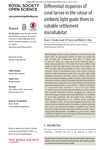Differential responses of coral larvae to the colour of ambient light guide them to suitable settlement microhabitat
| dc.contributor.author | Strader, Marie E. | en_US |
| dc.contributor.author | Davies, Sarah W. | en_US |
| dc.contributor.author | Matz, Mikhail V. | en_US |
| dc.date.accessioned | 2016-10-11T05:37:56Z | |
| dc.date.available | 2016-10-11T05:37:56Z | |
| dc.date.issued | 2015 | en_US |
| dc.identifier.other | HPU4160618 | en_US |
| dc.identifier.uri | https://lib.hpu.edu.vn/handle/123456789/23702 | en_US |
| dc.description.abstract | Reef-building corals produce planktonic planula larvae that must select an appropriate habitat to settle and spend the rest of their life, a behaviour that plays a critical role in survival. Here, we report that larvae obtained from a deep-water population ofPseudodiploria strigosasettled more readily under blue light and in the dark, which aligns well with the light field characteristics of their natal habitat. By contrast, larvae of the shallow-water coralAcropora millepora settled in high proportions under blue and green light while settlement was less in the dark. | en_US |
| dc.format.extent | 9 p. | en_US |
| dc.format.mimetype | application/pdf | en_US |
| dc.language.iso | en | en_US |
| dc.subject | Biology | en_US |
| dc.subject | Ecology | en_US |
| dc.subject | Settlement | en_US |
| dc.subject | Exposure | en_US |
| dc.subject | Green fluorescent protein | en_US |
| dc.title | Differential responses of coral larvae to the colour of ambient light guide them to suitable settlement microhabitat | en_US |
| dc.type | Article | en_US |
| dc.size | 611KB | en_US |
| dc.department | Education | en_US |
Files in this item
This item appears in the following Collection(s)
-
Education [806]

